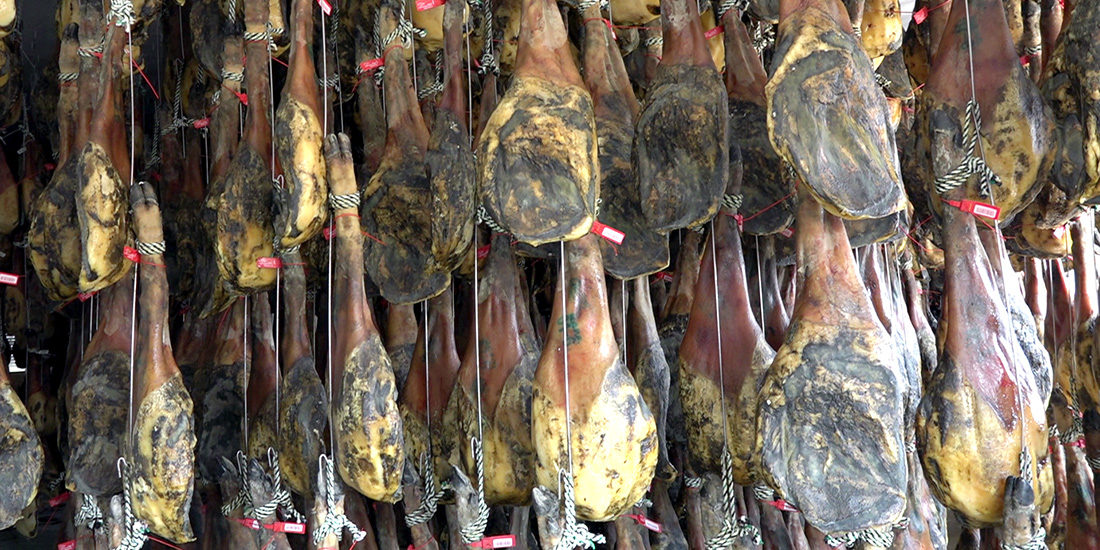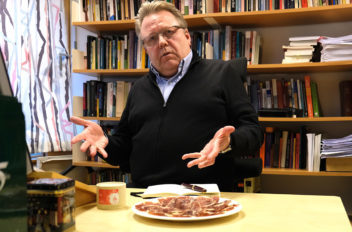How a black pig created an entire industry
Black Iberian pigs rooting for acorns under an idyllic grove of trees in a sunny landscape. This is the myth of the Spanish Ibérico ham.
Black Iberian pigs rooting for acorns under an idyllic grove of trees in a sunny landscape. This is the myth of the Spanish Ibérico ham.
Cured ham is made all over the world and isn’t necessarily expensive. But when people in Spain celebrate something important – or rich Chinese, Americans or Norwegians want to splurge – they often choose pata negra (black-hoofed) pigs from southern Spain for their celebrations.
Food anthropology is the branch of social anthropology that occupies NTNU Associate Professor Jan Ketil Simonsen. He heads a project that is exploring the cultural policies that Spain has implemented as cured ham production has grown from local small-scale operations to large-scale industrial production for the world market.
The exclusive and expensive Iberian ham is just the tip of a much larger industry.
“How food is produced and consumed provides insights into key social, cultural, economic and political processes in society,” says Simonsen.
He is joined in the project by NTNU colleague Lorenzo Cañás Bottos and Professor Peter I. Crawford from the University of Tromsø.
Together they are creating ethnographic films of the project.
- You might also like: Eiderdown farming — a living cultural tradition
Pigs on hillsides
When the Iberian pig forages for its favourite food, acorns, the nutty flavour is absorbed into the fat. This breed of pig is unique because it stores fat in muscle tissue, producing the ham’s marbling and much sought-after sweet taste.
“Today local foods and food festivals abound, which may appeal especially to the urban population, like Iberian ham does.”
The 20th century was a painful century for both the Iberian pig and its oak forests. When the country switched to industrial meat production, many of the oak forests were cut down and turned into fields for grain cultivation for animal feed. In the 1960s, the Iberian pig population was afflicted with African swine fever, a viral disease.
Iberian ham and sausage production stayed small-scale and local, with limited availability.
For at least 60 days before slaughter, a pig herder takes the pigs to the oak groves where the pigs feed exclusively on acorns, mushrooms and herbs. Video: Jan Ketil Simonsen
Forest pastureland threatened
By 1980, the pig population had shrunk so much that authorities initiated a rescue operation.
At the same time, UNESCO started a programme to save what was left of forest pastures in Europe. In southwestern Spain, the old oak groves (dehesa) were decimated by illegal logging.
In the 1990s, the EU allocated funding to replant oak forests in the province of Badajoz, and in 2002, UNESCO and the Spanish authorities created a biosphere reserve in the Sierra de Aracena, providing protected status for large forest pasturing areas.
- You might also like: An Italian agricultural community seen through a 50-year-old looking glass
Industry with idyllic façade
The rescue operations for the Ibérico pig and oak grove pasturelands laid the groundwork for industrializing Iberian pork production after 1990.
The capacity of the oak groves puts clear limitations on the production quotas of pure-bred pigs that can fatten up on acorns. These animals account for the most exclusive and expensive cured ham, jamón ibérico de bellota (bellota = acorn).
Only five per cent of Ibérico production attains this top quality classification.
“The image of happy, black free-range pigs under the oak trees is what the producers want to show on their websites and in their advertising.”
“Serrano is the more usual ham that is produced everywhere in Spain, and which is widely sold in Norwegian grocery stores. This ham comes from the Yorkshire breed of pigs which is the most commonly used breed in industrial production. High-quality Serrano ham, often from Teruel or Trevelez, can also be very expensive,” says Simonsen.
Big class differences
Traditionally, society in southwestern Spain was characterized by strong class divisions. Many of the large landowners lived in the cities, while poor and landless sharecroppers did the farm work.
This model was exported to South America when Spanish and Portuguese colonists found their way across the sea. The region’s cultural values, performances and the symbolic expressions associated with food traditions, the landscape, the animals and the division of labour were linked to the farm owners.
As the Ibérico industry emerged, the producers retained the cultural ballast from earlier small-scale operations. In addition, a new culture and new traditions around ham production were created to build the brand.
Building on exclusivity
Strict certification and controls were introduced to ensure exclusivity and authenticity. The EU has given protected trademark status to the oak forest pastures.
The forest pastures are unique biotopes involving particular plant species, animals and humans that have been cultivated over centuries.
Iberian ham is classified into four main groups using a colour-coded labelling system: black, red, green and white. The label depends on the breed, what the pigs eat, to what extent the animals have been free-range and how long the ham is cured.
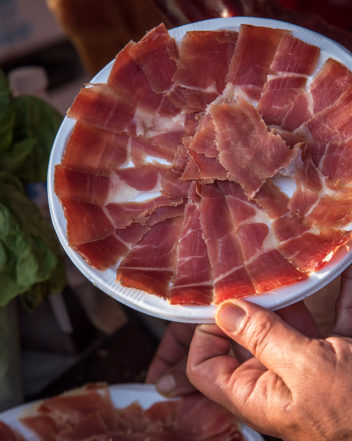
Expensive food: A whole Iberian ham with bone in usually costs from NOK 5000 and up in Norway, depending on quality. Illustration photo: Alex Kiriuchkov / Shutterstock / NTB scanpix
“The pure-bred Iberian pig, with a black label, tops the list. For at least 60 days before slaughter, a pig herder takes the pigs to the oak groves where they feed exclusively on acorns, mushrooms and herbs. The exercise they get is important for the quality of the meat. After salting and drying, the ham ages for up to four years,” says Simonsen, who knows the region and customs well.
The agricultural authorities regulate how many pigs can be fattened, depending on the year’s acorn production.
At the bottom of the list, with a white label, are cross-bred pigs that are fed grain and held in outdoor enclosures. The requirement for this classification is that the pig be at least 50 per cent Ibérico and that the ham mature for two years.
“Agritourism with farm stays, food and various experiences is growing. A tourist trail called the ham road, Ruta del jamón ibérico, has been established.”
The ham production that Simonsen and his colleagues are studying takes place in the province of Badajoz.
“The limited availability of ham from free-range pigs drives prices sky high. Scarce goods create high symbolic value that creates greater demand. Maintaining this exclusivity is important and is ensured through certification. Ibérico is a protected trademark. Hams from other places aren’t allowed to use that name,” says Simonsen.
The oak forest area stretches into Portugal, which has also begun to accelerate its Ibérico production.
More than ham
To further strengthen the brand, producers have established food festivals, pig exhibitions and various fairs. For example, Día del Jamón, the day of ham, is celebrated every year in September in the ham town of Monesterio.
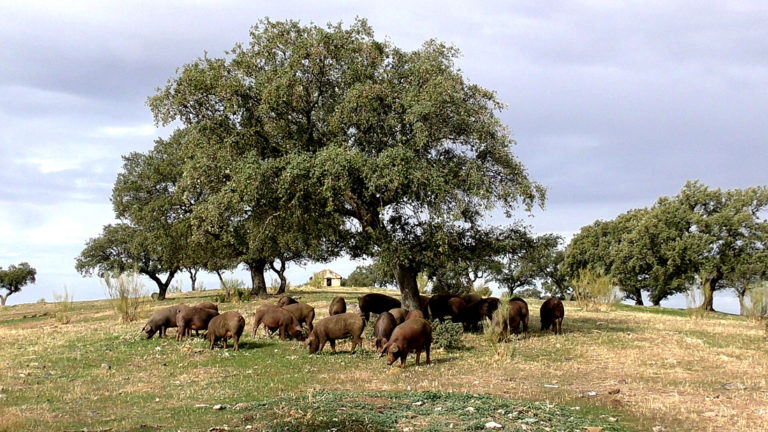
The image of happy black free-range pigs under the oak trees is what the producers prefer to show on their websites and in their advertising, says Jan Ketil Simonsen. Photo: Lorenzo Cañás Bottos
The process of slaughtering, salting, drying and cutting is highly specialized, and demonstrations and teaching of various techniques take place at festivals. Rituals are shared.
“The image that producers want to show on websites and in their advertising is one of happy black free-range pigs under oak trees. The pictures are “sanitized” of other livestock that feed in the oak groves, and of people. The landscape is presented as being the original and natural habitat – but only for the pigs. We want to investigate what effects this cultural reconfiguration of the pig’s importance and value has on the area’s economy and identity,” says Simonsen.
The researcher believes the industry plays on urban consumers’ notions of organic, clean, natural and healthy food, good animal welfare and sustainable practices. The fact that the item is special and scarce just reinforces its exclusivity.
Long path from hoof to product
Iberian pigs must be at least 11 months old before being slaughtered and should weigh at least 160 kilos. Feeding on acorns in forest pastures must last at least 60 days. The pigs eat up to 6-7 kilos of acorns daily. The nuts are rich in the same fatty acids as are found in olives. The hams are salt-dried, rinsed and hung to air dry for 6-9 months before hanging in curing rooms, called bodegas, for up to three years. Experts monitor the entire process, which is overseen by the agricultural authorities.
Simonsen refrains from expressing an opinion on whether the ham deserves to be perceived as healthy food.
Ripple effects
The new cultural ideas about the Iberian pig and its habitat have also provided a platform for new industries.
Agritourism that includes farm stays, food and various experiences is growing. A tourist trail called the ham road, Ruta del jamón ibérico, has been established. The Spanish countryside is struggling with the depopulating of rural areas, and local politicians hope that more diverse businesses centred around ham production can encourage young people to stay.
The financial crisis in 2008 hit the cured ham industry hard, especially the top quality classifications, and production declined. In recent years, however, the market has picked up again, not least thanks to rich Chinese people.
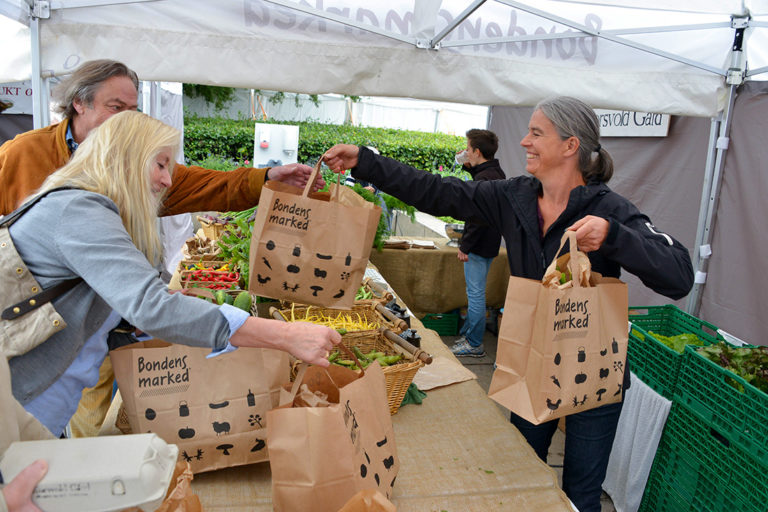
How food is produced and consumed provides insights into key social, cultural, economic and political processes in society, says Simonsen. He sees similarities between the Ibérico ham and Norwegian farmer’s markets . Photo: Tore Berntsen
Norwegian parallels
Simonsen sees some similarities with what is happening in Norwegian rural areas, both when it comes to building a local brand for food and food traditions and translating it into the experience industry.
“The Norwegian Minister of Agriculture Lars Sponheim stepped in to revitalize and develop local food production and farm tourism,” he says. “Today, local foods and food festivals are flourishing, and they tend to appeal especially to the urban population, just like the Ibérico ham does. They both share the concept of something exclusive, healthy and genuine. The popularity of the farmer’s market in Trondheim and the fermented fish festival in the mountain town of Fagernes have clear parallels with Día del Jamón.”
Little glossary of terms:
- Iberian pig – breed of pigs with black hooves and intramuscular marbling in the meat
- Pata negra – meaning black hoof, the nickname of hams from the Iberian pig
- Jamón ibérico de bellota – free-ranging pigs roam in oak grove pastures and are fattened on acorns to create this most exclusive ham
- Bellota – acorns
- Dehesa – woodland oak grove pasture
- Paleta – salt-dried ham of the forequarters (picnic or fore ham).
- Jamón – salt-dried ham of the hindquarters
- Latinfundio – traditional Spanish agricultural system characterized by properties with a high division of labour and a sharp distinction between landowners' families and landless farm workers
